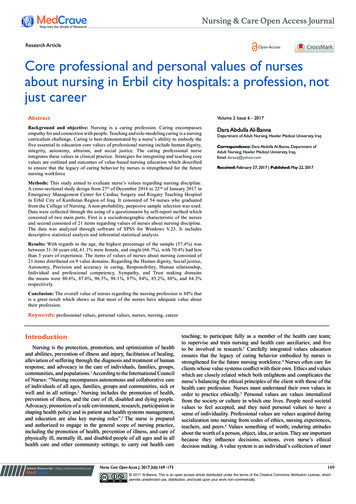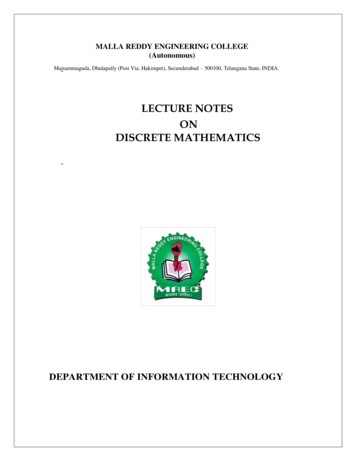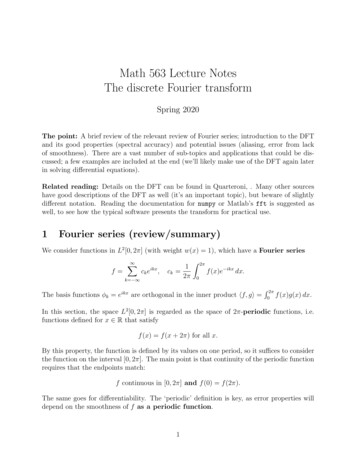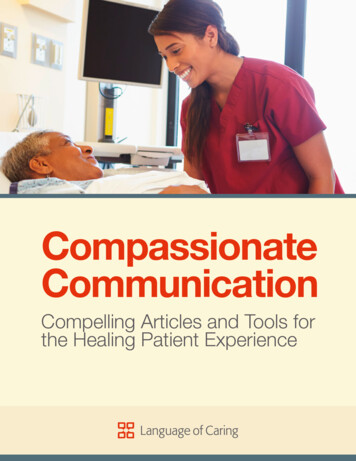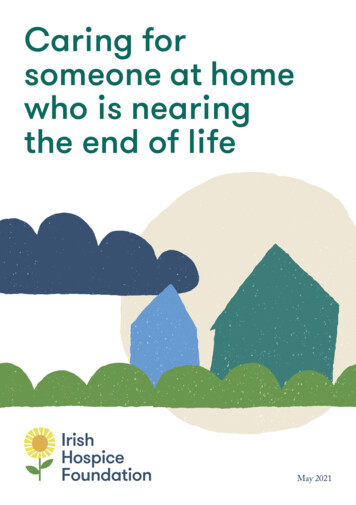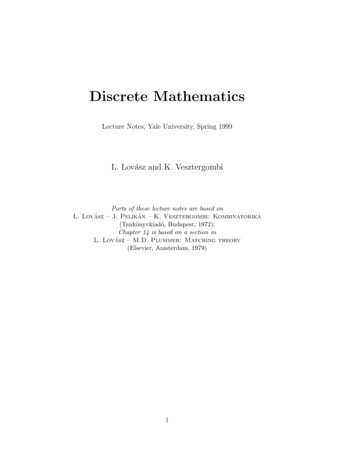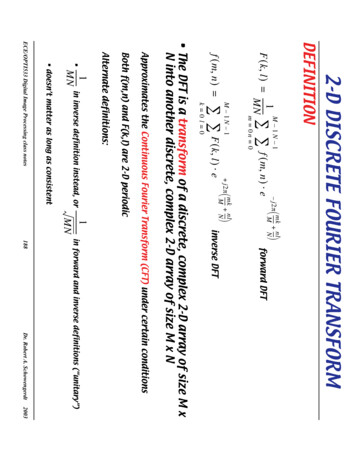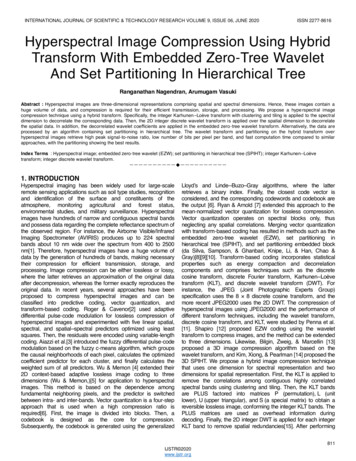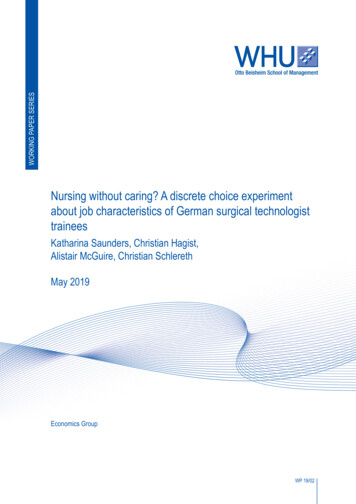
Transcription
WORKING PAPER SERIESNursing without caring? A discrete choice experimentabout job characteristics of German surgical technologisttraineesKatharina Saunders, Christian Hagist,Alistair McGuire, Christian SchlerethMay 2019Economics GroupWP 19/02
Nursing without caring? A discrete choiceexperiment about job characteristics ofGerman surgical technologist traineesKatharina SaundersWHU – Otto Beisheim School of ManagementChristian HagistWHU – Otto Beisheim School of ManagementAlistair McGuireThe London School of Economics and PoliticalScienceChristian SchlerethWHU – Otto Beisheim School of ManagementWorking Paper 19/02May 2019ISSN 2511-1159WHU - Otto Beisheim School of ManagementEconomics GroupBurgplatz 256179 Vallendar, GermanyPhone: 49 (261) 65 09 - 0whu@whu.eduAny opinions expressed here are those of the author(s) and not those of WHU. Research published in this series may include views on policy, but the institute itselftakes no institutional policy positions.WHU Working Papers often represent preliminary work and are circulated to encourage discussion. Citation of such a paper should account for its provisional character. A revised version may be available directly from the author.WP 19/02May 2019
AbstractWe know that existing professions in the health care sector value work environmentand job conditions to a great extent. However, we are also witnessing an expansion of new roles into the health care sector, many of which substitutie the tasks ofexisting professions. This may be efficient, in that it releases professionals’ time.However, there is little understanding of what motivates these new professions inentering or remaining in these newly created roles. This study tries to evaluate thepreference structure of one of these new staff groups, surgical technologist, throughexamining the preferences of trainees, defined over a number of attributes, in thisgroup. The DCE study covers 80% of the target population. The results show a vigorous disfavour towards any perceived nursing job characteristics such as caringactivities, hierarchical work environment or shift types. The results inform policymakers and hospital manager about the importance to focus not only on the nursingprofession but also to take into account the existence of a group of people whois willing to work within the health care system however, associated with strongpreferences against nursing activities, especially caring. Implementing and furtherdevelopment of new and specialised profession through reallocating former nursingtasks- should be considered while coping with labour shortage.JEL-Classification:I18, J08, J30, C93, C90Keywords:DCE, labour shortage, specialised health care profession, job preferencesCorresponding author:Katharina Saunders, Katharina.Saunders@whu.eduWP 19/02May 2019
1. IntroductionGermany, like many other OECD countries, faces a shortage of nurses, at least at the level ofthe individual hospital. In 2016, 51% of all German hospitals were unable to fill open nursingpositions, an increase of 14% in vacancies since 2011 (Blum et al. 2016). Affected hospitalslacked on average 6.6 positions. Within specialised units, like the operating room (OR), theshortage of (specialised) certified nurses is especially problematic as 44% of the Germanhospitals were, on average, not able to staff their open OR positions (Blum et al. 2016).Therefore, two positions on average are open in German ORs (Blum et al. 2016). To curb thisproblem in the OR, German hospitals started to train a new profession, “surgical technologists”from 1997 on (German Association of Surgical Technologists 2017). Surgical technologists arespecialised health care workers who act as substitutes for OR nurses in Germany, but they arenot certified and not allowed to work on the general ward. In contrast to Anglo-Saxon andScandinavian countries, Germany’s hospital system is de-centralised and the development of aspecialised health care workforce to assist or replace nurses has been comparatively slow.Surgical technologists are substitutes for certified nurses in the OR (or sometimes in theendoscopy unit of the emergency room) but lack the flexibility of certified OR nurses who canwork also on the general ward or in other units like intensive care. The education process tobecome a nurse or a surgical technologist is nearly similar regarding the timeframe. Bothoccupations undergo three years of training. The training for both professions includes regularschool attendance and working in different areas throughout the hospital. The surgicaltechnologist trainee is limited to the operation room, the emergency room and the endoscopyunit. An approximately six-week internship on a ward is included though. In contrary, thenurse’s trainee is allocated throughout the entire hospital.The main difference of the training lies within the range of duties. Whereby the nursingeducation focuses on a broad range of skills, including caring activities, the surgicaltechnologist s education aims to interfere solely special OR tasks such as preparing the ORroom and assisting the physician/surgeon. Due to the high versatility of a nurse, the nurse canchoose whether to work on the ward or in specialised units such as the OR. However, the tasksof a nurse or a surgical technologist within the OR are identical. A formal key determination ofboth occupations is the official certification of a nurse1, which is missing for the surgicaltechnologists. What does this mean for the parties involved? From a hospital provider position,financing the education of nurses in Germany is shared by the federal states as well as thesickness funds, which are reimbursing hospitals the educational costs. However, this is not thecase for surgical technologists; the hospitals face all educational costs on their own. From theregulation side, hospitals have a wide range of freedom when it comes to train these specialists,as legally in the end the physician is responsible for their actions. All certified professions areregulated and underlie special requirements by law, such as a standardised educationalcurriculum. Moreover, certified professions are associated with a secured occupational title,which allows only people with the relevant training to carry the official (job) title (GermanBundestag 2016). Furthermore, in line with the EU directive (2005/36/EG) certified professions1Government approved and regulated occupation.1
are acknowledged EU wide, which acknowledges that a health care profession is associatedwith having direct impact on people’s life.Surgical technologist is a non-certified profession and discussions are going on whether surgicaltechnologist is a health care profession at all. Even though, surgical technologists substitute ORnurses, it is claimed that a surgical technologist has less contact to a patient and thus a low riskpotential compared to other health care professions. What does this mean from a surgicaltechnologist s point of view? Due to the lack of flexibility and national and internationalcertification, one could argue that surgical technologists are a “dead end” job which gives theemployer adverse advantages. Career perspectives are also limited, as further trainings oftenrequire certified degrees. In addition, it is still legally challenging how surgical technologistswill be treated in the German social systems as they are officially classified as “unskilled” whichmight cause disadvantages in Germany’s social safety net. Moreover, the nurse’s paymentsticks to pay-scales supported by the labour union and binding for the respective hospital.Again, this is not the case for surgical technologists due to the missing certification. Thus,payment of a surgical technologist may vary depending on the hospital provider (private, publicetc.); however, on average the salary of a surgical technologist and a nurse is nearly similar.The number of surgical technologists has been steadily increasing. Therefore, one couldconclude that hospitals obviously are taking the costs of training, which they must covercompletely themselves, as a profitable investment. Another indicator for this is that the biggestsurgical technologist training schools are run by private hospitals. The larger economic questionis why people are deciding to opt for this career path when certified nurse spots are vacant?Therefore, we derive two main research questions: 1) What motivates surgical technologists tochoose a non-certified health care profession? 2) How important is the official certification tothe surgical technologists themselves?Understanding health care workers preferences, respectively the trade-offs that they face whilstchoosing a job, is crucial to enhance current recruiting strategies to cope with labour shortage.A suitable method to measure preferences and trade-off decisions is the discrete choiceexperiment (DCE). This method collect data using surveys and simplifies data analysis becausefactors of interest can be experimentally manipulated and tested in a controlled experimentalenvironment. Instead of relying on ratings or rankings that are artificially translated intopreferences, discrete choice experiments ask respondents to repeatedly make choices betweena carefully designed set of alternatives. Given the similarity to real-world purchase decisions,discrete choice experiments are able to explain actual purchasing behaviour well, and they havea firm foundation in sociology and behavioural research (Swait and Andrews 2003). Morespecifically, with random utility theory, these experiments are backed-up by a long-standing,well-tested theory of choice behaviour that can take inter-linked behaviours into account (see(McFadden 1974)2. For a review of the literature regarding DCE in health economics see Clarket al. (2014).Previous research on nurse’s shortage and nurse labour supply aimed to understand the nurses’choice behaviour. These studies mostly investigated the elasticity of the supply curveresponding to changes in wages or non-monetary characteristics. Di Tommaso et al. (2009)investigated the importance of wages for nurses in Norway in order to increase labour supply.The authors found labour supply rather inelastic and concluded a generic wage increase solely2More detailed information on DCE as a method can be found elsewhere Train 2009; Louviere et al. 2000.2
could not solve the labour shortage since non-pecuniary characteristics need to be taken intoaccount. Shields and Ward M. (2001) found the opposite, namely that absolute pay is the maindriver of job satisfaction. Hanel et al. (2014) found similar results as they identified the laboursupply elasticity tend to be higher than previous research suggested. Hence, an increase inwages to increase labour supply is more promising than expected. Phillips (1995) also foundrespondents to be highly responsive to wage changes. Yoo and Doiron (2013) set up a bestworst scaling experiment (Case 2) to compare preferences on nursing jobs and found strongermonetary preferences. In comparison, Kankaanranta and Rissanen (2008) found a rather smallwage elasticity, however identified a strong and significant impact on the working hourssupplied. The authors concluded a wages increase as inefficient to increase labour supply asnon-monetary characteristics play a major role. Heyes (2005) linked a nurse with a poor wageto higher performance on the job as the nurse experiences a stronger vocation towards the job.For a detailed information on these studies, please see Table A1 in the appendix.Taken together, we know that existing professions in the health care sector value workenvironment and job conditions to a great extent (Scott et al. 2015; Heyes 2005; Di Tommasoet al. 2009; Blaauw et al. 2010; Kankaanranta and Rissanen 2008). However, we are alsowitnessing an expansion of new roles into the health care sector, many of which substitute thetasks of existing professions. This may be efficient, in that it releases professionals’ time.However, there is little understanding of what motivates these new professions in entering orremaining in these newly created roles. This study tries to evaluate the preference structure ofone of these new staff groups, surgical technologist, through examining the preferences oftrainees.No study could be identified which focuses on specialised health care worker such as surgicaltechnologists during a literature research. Our study is, therefore, the first DCE to analysesurgical technologists, with a particular geographical focus on Germany. In addition, we are thefirst to collect data of surgical technologist on an academic basis, as the profession is notconsidered within the annual public statistical elicitation of profession due to the missingofficial certification. Moreover, we believe it to be the first DCE to study the job preferencesof specialised health care workers in general. Therefore, our paper has not only have academicvalue but is also providing information for policy-makers for questions such as an officialcertification of the ongoing debate about nurse’s shortages.2. Methods2.1 Overview of the studyThe study on surgical technologist’s trainee preferences through DCE took place acrossGermany between January and July in 2017. We decided to target surgical technologist traineesrather than to survey fully trained surgical technologists as we suggested the mind-set to be lessbiased through work experience regarding the decision why someone decides to opt for a noncertified position. Moreover, the personnel investment costs to undergo the training are not thathigh at this stage and thus might not be considered much on entry to the profession. Moreover,the choice of career and appropriate education is a fundamental individual professional entrychoice.This study included trainees of all training levels (year 1-3). We contacted training centres viaemail, of which thirty training centres agreed to participate. A formal study approval process3
took place, as every training centre required at least the approval of the CEO as well as of thehead of education. Within the majority, approval of the staff council as well as the data securitymanager were also mandatory. Most training centres requested paper-based surveys as theyacknowledged distributing the survey during class to maximise the responds rate. Paper-basedsurveys with a reply-paid envelope attached were sent out as well as an online-link to trainingcentres with appropriate email access for the trainees.The survey was generated using the software DISE (Schlereth and Skiera 2012). Initially,participants were provided with general background information regarding the survey contentand structure. We divided the survey into three parts. First, respondents answered sociodemographic characteristics followed by the DCE part with fourteen choice sets. The DCEinstruction for the participants stated to imagine the time before starting the training and askedin each choice set to choose among two possible provided positions the most favourable one.The survey finished with specific questions regarding the training. Respondents needed 15-20min to finish the survey. As an incentive for the respondent, we followed a common practiceand donated one euro to cancer research organisation for each completed survey. The authorsprivately funded the donation. No third parties were involved; hence, no conflict of interestexists.2.2 Selection of attributes and levelsFor the empirical study, we followed the approach suggest in Helter and Boehler (2016) andprimarily identified attributes through literature search as well as additionally experts’ talkswith politicians, teachers and health care professionals followed. After generating a draft of tenpossible attributes and levels, focus group interviews took place. All over, thirty surgicaltechnologists trainees participated. Attributes and levels were discussed regarding realism aswell as wording and comprehensibility. Subsequently, the focus group participants were askedto rank the possible attributes and levels in order to identify their importance. We identifiedeight attributes and their respective levels. In a pre-test study, which we ran with thirtyparticipants, we examined the feasibility as well as the tangibility of the questionnaire. Oneattribute had to be rejected completely as it led to massive confusion and thus the danger of abroaden bias within the results was too high. Furthermore, some changes in wording wererequired. Eventually, we identified seven final attributes and their respective levels as presentedin Table 1. After updating the survey, a second test round ran with ten participants, whichresulted into the eventually used questionnaire.4
Table 1: Summary of employed attributes and bute levelsL 1: yesL 2: noShift typesL 1: no weekend shiftsL 2: three-shift operationL 3: on-call dutyAutonomyL 1: low responsibilitiesL 2: distinct WorkloadL 1: friendly and open relationshipbetween physicians and other healthcare workersL 2: respectful and very professionalrelationship between physicians andother health care workersL 3: impersonal and formallyrelationship between physicians andother health care workersL 1: none to very low nursingactivitiesL 2: mostly nursing activitiesL 1: 2,500 L 2: 2,900 L 3: 3,300 L 1: lowL 2: middleL 3: highReasoningAttribute is of major interest and a key political issue. As the surgicaltechnologist profession is not officially approved, some disadvantagesfor the trainees as well as the hospitals arise. Hence, the attribute wasincluded to evaluate the value of a government-approved position from atrainee point of view.Shift types, especially the night shift can have negative effects on aperson’s health (Harrington 2001). In comparison to nurses, surgicaltechnologists are normally used to on-call duty after finishing time(amount of on-call duties depending on the size of the team);nevertheless, undesirable working hours are unavoidable. Work-lifebalance seemed highly correlating with control over the workingschedule (Tausig and Fenwick 2001);hence; this attribute was includedwithin the survey.Job satisfaction is associated with a highly autonomous workingenvironment, which the focus group participants emphasised. Theattribute was rather of a general nature to provide the respondents withmore flexibility through their own interpretation (Scott et al. 2015).A positive workplace environment can lead to a lager job satisfaction aswell as to higher motivational level (Nordin et al. 2017). In highdemanding jobs, like nursing, a positive workplace environment could beessential to cope with stress and other challenges more effectively. Weused “workplace environment” as an indicator for teamwork between allsort of health care professions.This attribute is of high relevance for our study as it is the most importantranked attribute within the focus group and during expert talks. Itconsists of two level, which allow us to evaluate if someone is in favourof nursing, or not. Hence, if one is also prone to become a nurse insteadof a specialised health care worker without any nursing activities.This attribute reflects recent average salary (before taxes) of a surgicaltechnologist as well as two changes in the salary, which were alignedwith experts to provide a realistic scenario.Workload is also a major determinant of job satisfaction. We kept theattribute more general with room for own interpretations as the workloadquiet differs depending on the hospital’s medical speciality and it s actualsize.5
2.3 Experimental designFor the 14 choice sets in the DCE, we employed the techniques in Street and Burgess (2007)and created a d-optimal (2 3 2 3 2 3 3) fractional factorial design. These designs provide a highdegree of efficiency (for our design 98% d-efficiency) and they are suitable for a diverse rangeof research questions. In our study, each choice set showed two different positions, which weillustrated in Table 2 and subsequently asked the respondent in which of the two positions theyrather prefer to work.Table 2: Illustration of a choice set1 OUT OF 14OFFICIALLY CERTIFIEDPROFESSIONJOB AyesJOB BnoSHIFT TYPESthree shift operationon call dutyAUTONOMYlow responsibilitiesdistinct responsibilitiesWORK ENVIORNMENTWORK CONTENTfriendly and open relationshipbetween physicians and other healthcare workersnone to very low caring activitiesimpersonal and formally relationshipbetween physicians and other healthcare workersmostly caring activitiesEARNINGS2,500 3,300 WORK LOADmiddlehigh We decided for the two alternatives, without an opt-out option as our target group consists oftrainees who already decided for the profession of a surgical technologists. An opt-out optionbears the risk of massive information loss (Louviere et al. 2000) as the respondent could use itas a quick way to finish the survey and the researcher is left to none information regarding theprior utility (Schlereth and Skiera 2017).2.4 AnalysisWe estimated preferences using a hierarchical Bayes procedure developed by Train (2009) inMatlab. We based our estimation on random utility theory (Thurstone 1927), thereby, makingthe implicit assumption that respondent h maximises his or her utility uh,i vh,i εh,i for theprofession i, where vh,i is the deterministic part of the utility function, which contains observableinformation, such as the attributes and levels shown in the choice sets and the observedcovariates of respondents. The error term, εh,i, is stochastic and explains unobserved behaviour.Louviere et al. (2000,p.8ff.) discussed related assumptions regarding the cognitive processes ofrespondents and the extent to which these assumptions are typically fulfilled.6
We used an additive model for the utility of the profession vh,i, consisting of a vector ofparameters βh to be estimated times the effects-coded design vector Xi; (i.e., vh,I βh Xi). Forthe error term εh,i, we followed the work of McFadden (1974), and assumed an extreme valuedistribution. This distribution has a similar functional form as the normal distribution, but itprovides appealing mathematical properties, such that computers can quickly calculateprobabilities in a closed form. For each choice set a, the probability that respondent h choosesprofession i is:(1)Prh ,a (i ) exp(vh ,i ) exp(vi ' Cah ,i ')(h H, i I, a A),where H refers to the set of respondents, A to the set of choice sets and Ca to the set of shownprofessions in choice set a. Train (2009, p.34ff) provided the full mathematical derivation forthe logit model, and discussed the underlying assumptions. Furthermore, Chandukala etal.(2007) summarised related work to the logit model, which challenged its mathematicalproperties. They concluded that even though some of the assumptions are violated (e.g., theextreme value distribution of the error term) that the estimated parameters captures theunderlying preferences very well.Despite observing just 14 choices, we were able to obtain a vector of individual parameterestimates βh for each respondent through the use of hierarchical Bayes estimation techniques(c.f., Rossi and Allenby, 2005 for an exhaustive, statistical introduction and Train, 2009 for itsuse in case of discrete choice experiments). Hierarchical Bayes estimates the results on twolayers: The higher level captures the aggregated behaviour of households, i.e., it assumes thatthe behaviour of all households can be described by a distribution, which is multivariate normalin our case. At the lower level, we captured household specific behaviour. Thereby, we assumedthat, given an individual's parameters, the multinomial logit model governs his/her probabilityof choosing a particular alternative.To obtain the parameter estimates, hierarchical Bayes uses an iterative process, the Monte CarloMarkov Chain: the estimates in each iteration are determined from those of the previousiteration by a constant set of probabilistic transition rules that are described in Train (2009).The iterative process is quite robust, and its results do not depend on starting values. In ourcase, we used 40,000 iterations, of which we removed the first 30,000 burn-in iterations. Theremaining 10,000 iterations served as input for the estimation. Each draw is one point formingtogether a distribution, i.e., the posterior distribution.In contrast to classical estimation, we did not interpret significant levels, such as t-test statistics,when estimating with hierarchical Bayes. The reason is that the posterior distribution nearlyalways is significant, because of the high number of iterations that is commonly used.We tested for robustness of the results. In particular, we wanted to avoid that average values ofparameter estimates were affected by parameter estimates of very few respondents. Therefore,we randomly assigned respondents into two data sets, and re-ran the estimation again, wherewe found similar results. We also tested, whether online surveys provided substantially differentresults compared to the surveys from the classroom, but again, found qualitative similar results.7
3. Results3.1 Respondent characteristicsOne thousand and sixty four surgical technologists’ trainees completed the survey. This is aresponse rate of 89%3 and covers approximately 80% of the total surgical technologists traineepopulation (n 1342). Given that we covered nearly the whole target population, we argue thatthe results are representative without any selection bias. Compared to other studies, we wereable to examine a very large share of the population (see appendix, Table 1). We do not provideonline results and paper-based results separately since 95% of the respondents filled out thepaper-based survey, and only 5% took part online4. 82% of the respondents were females whichclearly emphasises the dominance of female population of health care workers (WHO2008;OECD 2017). The average age was 22 years, independent of gender. Respondent’strainings level as well as the current workplace provider were equally distributed. Nearly halfof the respondents, i.e., 49%, have high school certificates equivalent to university entrance inGermany5. For detailed information about the respondent’s characteristics, see Table 3.Table 3: Respondent characteristicsNumber of ORT traineesPersonal resp. characteristicsFemaleMaleAverage age femaleAverage age maleEducational backgroundSecondary modern school qualificationHigh-school diplomavocational baccalaureate diplomaA levelUniversity studiesYears of training1st year of training2nd year of training3rd year of trainingCurrent workplaceUniversity hospitalPrivate hospitalPublic hospitalEcclesiastical hospitalNot sureSurvey respondents1,064Percentage share6Total population 1,3427 (80%)87618822.3 years22.4 7%33%30%20620724430310419.3%19.3%23%28.5%10%31200 paper-based survey were distributed.Only few training centre provide an email account for the trainees and distributing the survey via private email accounts israther difficult in terms of data security.5Nursing training nor surgical technologist training is a university degree in Germany.6 Rounded number.7 German Government, 2014.48
3.2 DCE results - Parameter estimates and importance weightsTo test for goodness of our estimation, we calculated internal and predictive validity in termsof first choice hit rates. Thereby, we excluded two choice sets from the estimation andcalculated for the internal validity, i.e., the percentage of choice sets, in which the chosenalternative actually had the highest deterministic utility according to the individual parameterestimates. For the predictive validity, we calculated the same percentage for the two choice sets,which we did not use for the estimation. The internal first choice rate is 99.65% and thepredictive first choice hit rate is 82.01%. All first choice hit rates vastly exceed the 50%threshold of a random choice. Table 4 shows the averages over respondents’ parameterestimates for each attribute level and their corresponding importance weights for each attribute(calculated for each attribute j as IWh,j (max(ßℎ,𝑗 ) min (ßℎ,𝑗 ))/ 𝑗 𝜖𝐽(max (ßℎ,𝑗′ ) min (ßℎ,𝑗′ ))). All parameters are of expected sign.Earning was the most important attribute with an average importance weight of 28%; workcontent followed on second place with 25%, implying that nursing activities provided a highdisutility for the choice of a profession. A friendly and open relationship between the team andthe physicians, hence, an enjoyable work environment was also key to the respondents.However, when it comes to working hours, free weekends are privileged. In support of thisconclusion, a three-shift system as well as an on-call duty regime are both not a favoured optionto respondents. A three-shift system is commonly part of a nurse’s job in Germany, where anon-call duty regime is often associated with working in a specialised unit within the hospitalsuch as OR s. Autonomy, defined as distinct responsibilities being preferred over lowresponsibilities, however does not affect the respondents greatly with an average importantweight of 8.1%. The official certification of the surgical technologist’s profession seemed ratherunimportant to the participants. This might derive from the outstanding labour market situationin health care, whereby people do not expect unemployment hence any disadvantages.Workload was the least important attribute, whereby high workload is associated with a utilityloss. Interestingly, an average amount of workload (middle) was also preferred over a lowamount of workload.9
Table 4: Results HB estimationAttributeLevelOfficial recognised profession - YesShift types -NoNo weekend shiftsThree-shift operationOn-call dutyAutonomy - Low responsibilities- Distinct responsibilitiesWork environment - friendly and open relationship b
Surgical technologist is a non-certified profession and discussions are going on whether surgical . etc.); however, on average the salary of a surgical technologist and a nurse is nearly similar. . (Scott et al. 2015; Heyes 2005; Di Tommaso et al. 2009; Blaauw et al. 2010; Kankaanranta and Rissanen 2008). .
